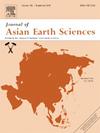Sedimentary evolution for the Wuling secondary rift of the western Nanhua Rift and exhalative-sedimentary mineralization cycles of “Datangpo-type” manganese ore deposits in South China
IF 2.7
3区 地球科学
Q2 GEOSCIENCES, MULTIDISCIPLINARY
引用次数: 0
Abstract
The “Datangpo-type” manganese ore deposits, hosted within the Neoproterozoic Nanhua system (Pt33n) in the Tongren area of northeastern Guizhou Province (China), represents a newly identified deep-seated manganese-bearing fluid exhalative-sedimentary deposit. Using basic theories and methods of basin analysis and sedimentology, the main ore-bearing structural unit of the Songtao–Guzhang graben (level III) in the Nanhua Rift was analyzed to determine the metallogenic mechanism and distribution law governing Datangpo-type manganese ore deposits, with systematic focus on the sedimentary facies and depositional environments of the Nanhua system. Analysis revealed that the sedimentary characteristics of terrigenous clastic rocks and the vertical evolution of sedimentary facies in the Nanhua system reflect a complete rift-filling sequence, i.e., sections of initial, accelerated, rapid, decelerated, and ceased subsidence filling. The spatial distributions and vertical changes in rhodochrosite ore beds in terms of structure, thickness, and grade were obviously controlled by the rift stage and changes in the exhalative strength of the manganese-containing fluid, in addition to the sedimentary environment and sedimentary process. The strata hosting rhodochrosite ore beds are located mainly in the basal part of the first member of the Datangpo Formation, i.e., at the bottom of the section of rapid subsidence filling, which is a product of deep manganese-containing fluid exhalative-sedimentary processes from the early stage of maximum rifting. The exhalative-sedimentary processes of ore-forming materials exhibit five major macrocycles, and reveal spatiotemporal patterns in the mineralization of rhodochrosite ores across the study area.

华南西部南华裂谷武陵次级裂谷沉积演化与“大塘坡型”锰矿床喷—沉积成矿旋回
大塘坡型锰矿床赋存于贵州东北铜仁地区新元古界南华体系(Pt33n)内,是新近发现的深部含锰流体喷淋沉积矿床。运用盆地分析和沉积学的基本理论和方法,对华南裂谷松桃-谷章地堑(三级)主要含矿构造单元进行了分析,确定了大塘坡型锰矿床的成矿机制和分布规律,系统地研究了华南体系的沉积相和沉积环境。分析表明,南华体系陆源碎屑岩的沉积特征和沉积相的垂向演化反映了完整的裂谷充填序列,即初始、加速、快速、减速和停止沉降的充填剖面。在构造、厚度、品位等方面,菱锰矿床的空间分布和纵向变化明显受断裂阶段和含锰流体喷发强度变化的控制,同时受沉积环境和沉积过程的影响。菱锰矿床赋存地层主要位于大塘坡组一段基底,即快速沉降充填段底部,是最大裂陷期早期深部含锰流体喷发-沉积作用的产物。成矿物质的喷淋-沉积过程表现为五大大旋回,揭示了研究区内菱锰矿成矿的时空格局。
本文章由计算机程序翻译,如有差异,请以英文原文为准。
求助全文
约1分钟内获得全文
求助全文
来源期刊

Journal of Asian Earth Sciences
地学-地球科学综合
CiteScore
5.90
自引率
10.00%
发文量
324
审稿时长
71 days
期刊介绍:
Journal of Asian Earth Sciences has an open access mirror journal Journal of Asian Earth Sciences: X, sharing the same aims and scope, editorial team, submission system and rigorous peer review.
The Journal of Asian Earth Sciences is an international interdisciplinary journal devoted to all aspects of research related to the solid Earth Sciences of Asia. The Journal publishes high quality, peer-reviewed scientific papers on the regional geology, tectonics, geochemistry and geophysics of Asia. It will be devoted primarily to research papers but short communications relating to new developments of broad interest, reviews and book reviews will also be included. Papers must have international appeal and should present work of more than local significance.
The scope includes deep processes of the Asian continent and its adjacent oceans; seismology and earthquakes; orogeny, magmatism, metamorphism and volcanism; growth, deformation and destruction of the Asian crust; crust-mantle interaction; evolution of life (early life, biostratigraphy, biogeography and mass-extinction); fluids, fluxes and reservoirs of mineral and energy resources; surface processes (weathering, erosion, transport and deposition of sediments) and resulting geomorphology; and the response of the Earth to global climate change as viewed within the Asian continent and surrounding oceans.
 求助内容:
求助内容: 应助结果提醒方式:
应助结果提醒方式:


